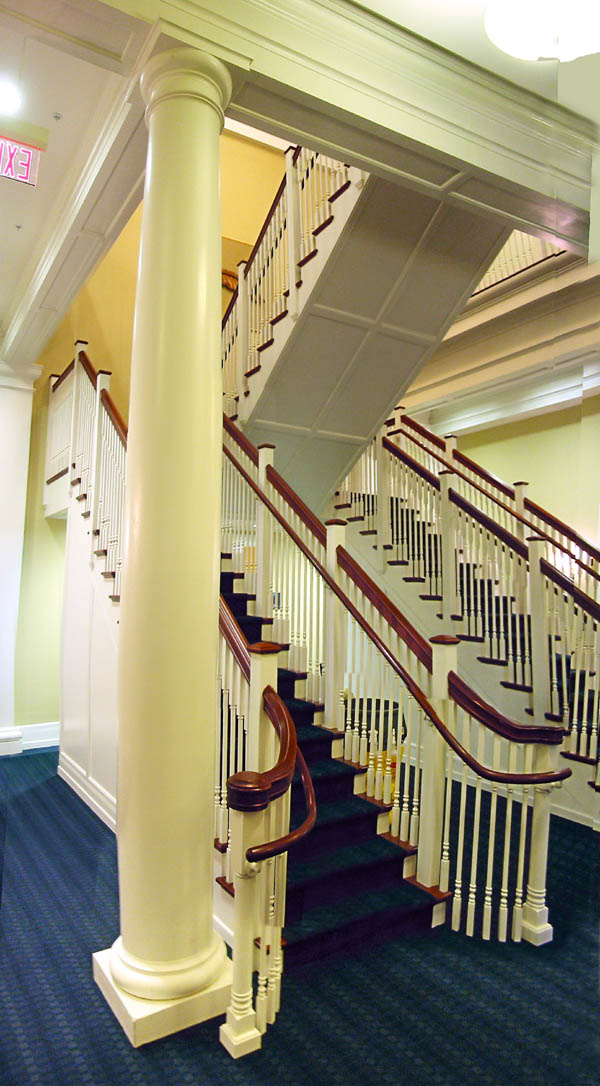Bottom & links
HOW SWARTHMORE CHOSE EXCELLENCE
A Brief Sketch of the Late 1800s
Jerry Nelson '65 2 June 2015 900 words
SUMMARY:
The President not the Board first drove Swarthmore to excellence.
-----=o=-----
Tumultuous events of the 1800s made it clear Swarthmore would not go
away, but left Quakers with the problem of what to do with it.
Eleven years after the Great Fire of 1881 destroyed Parrish Hall, the
local Hicksite community put it back, the children of the preparatory
school were sent elsewhere, and Swarthmore College became **only** a
college.
Quaker simplicity (think: Shaker furniture) means not throwing money
around. Presidents pleaded with the pinch-penny Quaker Boards to
go out and raise more money to sustain a national-level college
program. The Board pushed back, Presidents quit, and the College
oscillated with its own idea of its own future.
Denominational school or national institution? As the college
vacillated in its concept of itself, the Board of Managers caught a
glimpse of a strictly denominational college, forever an educational
backwater, forever low on enrollments, income, and funding.
The Board woke from their own nightmare and offered the Presidency to a
leading academic figure who said, Sure, he'd be there as soon as the
Board proved they were serious by adding $16 million (current dollars)
to the endowment! (Joseph Swain, 1857-1927; President 1891-1921; he
asked for $600,000).
Swain threw in the demand that he control faculty hiring, firing and salaries.
"Orthodox Quaker" Haverford was up and running when Swarthmore was just
a gleam in the eye of the more rural, less sophisticated Hicksite
Quaker break-aways, whose Edward Parrish spent years on horseback
rustling money to build the hall that carries his name.
But 1902 was not 1861-1869, and now the Hicksite Quakers included the
Strawbridge and Clothier department store owners. Philadelphia Hicksite
Quaker society raised the money and Swarthmore never looked back.
Academic excellence, the funds to support it, and unity in fund-raising
and philosophy between the Board of Managers and a powerful President
reach 113 years from that time to this one.
Perhaps Swarthmore did not look back, but Swain did. He repeated
his tactic again six years later for a similar amount from the Quakers,
and even more from Carnegie's steel money. He wanted to put
Swarthmore's faculty on the Carnegie Foundation for the Advancement of
Teaching's pension program, a forerunner of today's TIAA-CREF (Teachers
Insurance and Annuity Association-College Retirement Equities
Fund). Swain wanted to qualify also for funds from the Andrew
Carnegie Foundation (build a library) and other sources which could not
be awarded to any sectarian institution.
Was Swarthmore a sectarian Quaker school? The Board (Edward Hicks
Magill) had protested in 1905 that Swarthmore College was not operated
as a sectarian school, but the Carnegie Foundation wanted a more
structural expression of non-sectarianism. In 1908, Swain got the
Board to formally rescind the requirement that Board members be
Quakers. Swain secured non-sectarian funding, but it was 30 years
(1938) until the first non-Quaker ever held a Board seat at Swarthmore.
WHEN IT DOES NOT WORK OUT
Other schools have lived first hand the nightmare that Swarthmore's Quakers
walked us all away from. Virginia's Sweet Briar is a painful
example.
http://www.washingtonpost.com/news/grade-point/wp/2015/04/27/sweet-briar-administration-says-faculty-lawsuit-is-just-an-attempt-by-professors-to-get-a-financial-windfall/
As saddened as I am by our Board's failure to recognize the greatest
issue of our times and respond to it with divestment from the fossil
fuel industry, join me in praising over a century of wise management
that created our endowment in the first place. James Michener '29
described what happens when strong management fails.
"I have been involved in the finances of some dozen colleges and
universities." The gulf separating a well-funded, prudently
managed school from one lacking funds grows to a chasm beyond
words. The path downward is inexorable. "A reasonably good
college falls into the hands of a careless board. Expenses mount as
enrollments decline. Some eighty per cent of the faculty are on
tenure and refuse to retrain themselves so as to qualify for teaching
the subjects that students need. Such funds as are available are
poorly invested, and only casual efforts are made to enlarge
them. Decisions are postponed. Drift becomes king. And the
college staggers toward extinction."
Walton, Richard J. "Swarthmore College - An Informal History."
Swarthmore, PA: Swarthmore
College, 1986. James A. Michener '29 Introduction, p.X; p.21.
PROTECT THE ENDOWMENT
Now, as then, our position as an elite national institution still ends
if the money fails. But 123 years later, we are endowed.
Today, the money comes mostly from our endowment, with yields having
recently (15 years) risen from about one-third to nearly two-thirds of
our annual run rate. The endowment must be protected, but how
complete will protection be in today's turbulent times?
The greed and recklessness that caused the 2008 banking collapse were a
greater challenge to our endowment than shifting funds in order to
divest from the fossil fuel industry. The coming disruptions of
political and economic life from climate change will likely unleash
greater forces than any investment firm can neutralize, because they
are chaotic. Our Investment Committee stands in the calm before
the storm, hypnotized by small concerns they want us to share.
Swarthmore's position as an elite national institution ends if the
money fails, but our leadership has always come from the courage to
make decisions of personal conviction about matters of social
justice. The money must not fail; therefore, endowment changes
will be slow. Our leadership must not fail. Guardians of the
endowment cannot block all change and forbid others to make decisions
of personal conviction about matters of social justice concerning a
College shared by us all.
--end

top
resource & document list
Resource 1, Petition: http://swatmj.org/petition/
Resource 2, Two
Plans for college
donations.
Resource 3, document: "We
Divest for Social Ostracism and Public Humiliation"
Resource 4, document: "Why
We Can Never Divest Again
Resource 5, document "Fossil
Fuel Divestment FAQ"
Resource 6, YOU ARE HERE: "Swarthmore
Chooses Excellence in the 1800s."
